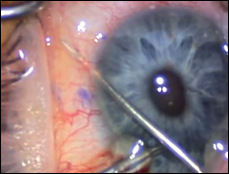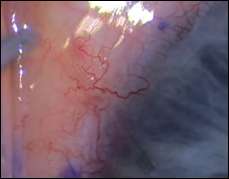MIGS provides early, effective glaucoma treatment
Micro-invasive glaucoma surgery is providing long-term IOP control for patients with mild to moderate glaucoma and allowing clinicians to intervene earlier in the glaucoma lifecycle
The benefits of micro-invasive glaucoma surgery (MIGS) are overwhelming and revolve around safety, according to John Berdahl, MD, in an interview with Primary Care Optometry News.

“Surgeons across the U.S. are flocking to these procedures,” he said. “Drops can take care of mild to moderate glaucoma, but we know patients are not good at using them, and they have their own side effects.
“We’ve known that trabeculectomies and tube shunts can get pressure low for a long time, but that comes with a safety risk,” he continued. “Many patients’ glaucoma isn’t severe enough to warrant the risk that comes with these traditional surgeries.
“With MIGS, we can lower eye pressure without patients having to take medication, or we can reduce the amount of medications they need while still not subjecting them to the risks of traditional glaucoma surgery,” Berdahl, who practices at Vance Thompson Vision Institute in Sioux Falls, S.D., added.
PCON Editorial Board Member J. James Thimons, OD, who practices at Ophthalmic Consultants of Connecticut in Fairfield, echoed Berdahl’s sentiments.
“A large part of the appeal is that many of the MIGS procedures have a great potential for common use,” he said in an interview.

Brett G. Bence, OD, FAAO, who practices at Northwest Eye Surgeons in Seattle, was a panelist for the Glaucoma Section Symposium on MIGS at the American Academy of Optometry’s annual meeting in Chicago. He said MIGS procedures are designed to augment one of three portals of aqueous outflow: to the subconjunctival space, to Schlemm’s canal and collector channels, or to the suprachoroidal space for enhanced uveoscleral outflow.
Elizabeth Muckley, OD, FAAO, of Northeast Ohio Eye Surgeons, has lectured across the country on MIGS and believes optometrists are equipped to manage these patients pre- and postoperatively. Her talks ensure that practitioners are informed of the current surgical offerings and how comanagement is possible and essential.
To properly comanage these procedures it is necessary to know how they work, she said, the typical IOP drop associated with each and potential complications.
The iStent
The FDA approved the iStent (Glaukos) in 2012 for use at the time of cataract surgery, and it is now the most commonly used MIGS procedure in the country, Thimons said.
“The first unit was very successful from an outcomes standpoint,” Thimons said. “There is a notable difference in the number of patients who don’t need medications after surgery and in the total number of medications used.”

He explained that the iStent bypasses trabecular resistance, which accounts for the majority of IOP concerns. It is placed in Schlemm’s canal at the time of cataract surgery and extends into the anterior chamber.
“Typically, it is stable over the patient’s lifetime and requires gonioscopy to visualize,” Thimons said. “There is a rare occurrence of microhyphema at the time of insertion – and even less so over time.”
The iStent consistently decreases pressure, “24/7, an underappreciated component of the cataract/Glaukos combination for IOP reduction,” he said.
CyPass

The CyPass (Alcon) device is placed between the ciliary body and the sclera, creating a cleft, which becomes the channel for fluid outflow, Thimons explained. The device can be used with an iStent.
“With MIGS procedures, many of them are additive to each other,” he said. “Unlike trabeculectomy, where it’s the last step in the process, MIGS is limited only by the creativity of the surgeons.”

He said the potential for devices to be used together is exciting and will evolve as the technology advances and comfort with the procedures grows.
The CyPass removes the need for one IOP-lowering drug, perhaps more, Thimons said. The procedure has a relatively low complication profile and minimal risk of hypotony. The most likely side effect is hyphema.
Xen gel stent
Allergan launched the Xen gel stent in 2017 in the U.S., and this procedure can be done independent of cataract surgery, as it is labeled for refractory glaucoma, Berdahl said.
Thimons noted that the device uses a transscleral route to achieve a low bleb.
Three-year data show a reduction of about 10 mm Hg, which is equivalent to using about two drugs, he said. Xen, however, comes with a greater risk of hypotony.
Canaloplasty
Canaloplasty widens Schlemm’s canal via insertion of a polypropylene mesh and the exertion of medially directed pressure, Thimons said. It can be performed with or without cataract surgery.
The clinical trials demonstrated a decrease in IOP of about 10 mm Hg, he said.
“While good pressure reductions are seen with the procedure, it is technically more difficult and time consuming,” Thimons said. “As a result, fewer surgeons perform the procedure even though the outcomes are gratifying.”
Trabectome, Kahook Dual Blade
This NeoMedix Trabectome and the Kahook Dual Blade (New World Medical) work similarly, opening the trabecular meshwork with a blade and defacing the trabeculum to access Schlemm’s canal, Thimons explained.

The trabeculum provides resistance to 75% of the outflow in the eye, he noted.

Results from these procedures are short-term, but they can be repeated and performed with or independently of cataract surgery, he added.
Transconjunctival photocoagulation
As with trabeculotomy, transconjunctival photocoagulation (TCP) can also be performed without intraocular surgery. In the past it has typically been used in patients who have failed other interventions, but today it has undergone a resurgence and is being used at various levels of glaucoma, Thimons said. It typically can demonstrate about a 30% reduction in previously treated eyes.
TCP ablates the ciliary body processes using a laser (Iridex Micropulse System) and bypasses the outflow issue by decreasing the volume of fluid produced in the eye. The laser focuses deep into the ciliary body and can be titrated for the level of IOP reduction, Thimons said.
He said there are few side effects, but, also like the trabeculotomy, it may require retreatment, as the ciliary processes can regenerate.
However, Bence noted that overtreatment with TCP also carries a risk of hypotony.
“Caution is needed, as this procedure is irreversible,” he said.
Goniotomy
“Goniotomies, or complete removal of the trabecular meshwork, have historically been performed in children for congenital glaucoma,” Bence said. “Recently, we are seeing this procedure used in adult open angle glaucoma with good results.
“Unlike the Trabectome or Kahook Dual Blade procedures, where 120 degrees to 150 degrees of trabecular meshwork are opened,” he continued, “goniotomies are often completely encircling.”
Bence noted that goniotomies are frequently reserved for patients with uncontrolled high pressure.
Gonioscopy-assisted transluminal trabeculotomy
With gonioscopy-assisted transluminal trabeculotomy, a complete trabeculotomy is performed, with 360-degree removal, Bence explained, unroofing Schlemm’s canal for direct access of aqueous through the primary drainage system of the eye.
Patient selection, preop, postop care
“Anything we can do to intervene in glaucoma earlier to avoid advanced procedures, to flatten the diurnal curve, is definitely something we need to educate patients on and to take ownership of,” Muckley said.
She encourages practitioners to be informed of the current surgical offerings.
“We are the primary care optometrists, we counsel our patients more and we should let our patients know these surgeries are available, especially earlier in the glaucoma continuum,” Muckley said.
Berdahl said his procedure choice is based on the patient’s risk:benefit profile.

“If a patient has a form of glaucoma that’s not very aggressive, I will do a trabecular bypass approach,” he said. “If the patient has a more aggressive form, then I’ll do the suprachoroidal space or subconjunctival, or perhaps combine procedures.”
“If you’re looking for a procedure that is capable of eliminating one drug from the treatment regimen, iStent achieved that in 72% of patients in the original study,” Thimons said, “and CyPass gets you into the 90% range for one drug. Xen can give you sometimes up to two drugs of control.”
Muckley noted that only one iStent is FDA-approved; however, “studies have shown that two iStents work best. Currently, Glaukos has the iStent inject under investigation, which contains two iStents in a preloaded applicator.
“Until that is FDA-approved, patients can be offered a second iStent off-label but will have to pay out-of-pocket for the second iStent, and an Advance Beneficiary Notice of Noncoverage must be signed,” she added.
There are few contraindications to MIGS procedures, Berdahl said.
“If they have a closed angle, then going into the trabecular bypass isn’t going to work that well, and you’ll want to go subconjunctival or maybe supraciliary,” he said. “If the lens is really loose, you don’t want hypotony, so you may want to avoid a subconjunctival procedure because we don’t want the lens to come forward.”
The preoperative process is like any glaucoma surgical evaluation with, “a thorough review of the anatomy, making sure patients understand exactly what is available and what tissue may or may not have been damaged by prior surgery, trauma, inflammation or neovascularization,” Thimons said.
As long as the entire anatomy is not damaged there is still the potential to apply MIGS in some capacity, he said.
As these are mostly angle-based surgeries, it is important for optometrists to continue to maintain their gonioscopy skills and fully understand the angle, Muckley said. Poor angle structure or advanced disease would disqualify a patient as a candidate for these procedures.
The anatomy of the eye would not tolerate it, Thimons added.

During postoperative care, comanagement is similar to that of a cataract patient, Muckley said. However, once the pressure drop starts, which occurs with the iStent at about 4 to 6 weeks, medication needs to be modified.

“It’s essentially the same postop regimen with the same type of anti-inflammatory medication, antibiotics and so forth,” she said.
Bence noted that with goniotomies, postoperative care includes the use of pilocarpine for 10 to 14 days immediately after surgery, along with anti-inflammatories and antibiotics.
“This helps prevent iris-to-trabecular meshwork adhesions or peripheral anterior synechiae,” he said.
“Once a patient has a full, completed, successful procedure they fall back into the same category as if they were taking medication, it’s just the medication is largely being replaced by the procedure,” Thimons added.
Practitioners need to monitor visual fields, optical coherence tomography images, corneal hysteresis – “the typical factors need to be kept in play,” he said.
The management of the patient does not change, which can confuse practitioners, Thimons added.
“It’s still the management of a patient going forward as a glaucoma patient, we just use a different modality to achieve the control of the pressure,” he said.
Optometric comanagement of MIGS is an evolving process.
“The more experience we gain from these procedures and the immediate and extended postsurgical course, the more we can share with referring doctors on how they can best follow these patients back at their offices,” Bence said.
MIGS is opening the door to better comanagement and an improved understanding of glaucoma treatment and management, he said.
Berdahl added: “MIGS is a comanageable procedure. The safety profile is so good that it allows patients to get more of their care in excellent hands closer to home.” – by Abigail Sutton
- References:
- A study to assess long-term safety of the CyPass micro-stent in patients completing the COMPASS trial. https://clinicaltrials.gov/ct2/show/results/NCT02700984. Accessed November 15, 2017.
- Reduced IOP with CyPass plus phaco maintained at 2 years. https://www.healio.com/ophthalmology/glaucoma/news/online/%7Beb0a2295-f6b0-4c98-9f45-d5fca954290c%7D/reduced-iop-with-cypass-plus-phaco-maintained-at-2-years. March 6, 2017. Accessed November 15, 2017.
- For more information:
- Brett G. Bence, OD, FAAO, can be reached at: bbence@nweyes.com.
- John Berdahl, MD, can be reached at: john.berdahl@vancethompsonvision.com.
- Elizabeth Muckley, OD, FAAO, can be reached at: dredm1@aol.com.
- J. James Thimons, OD, can be reached at: jthimons@sbcglobal.net.
Disclosures: Berdahl consults, advises or is a speaker for: Alcon, Allergan, AMO, Avedro Aurea Medical, Bausch + Lomb, Calhoun, Clarvista, Dakota Lions Eye Bank, Digisight, Envisia, Equinox, Glaukos, Imprimis, Iantech, New World Medical, Ocular Therapeutix, Omega Ophthalmic, Ocular Surgical Data, Sightlife Surgical, Vittamed, Vance Thompson Vision and Veracity. Bence, Muckley and Thimons report no relevant financial disclosures.
